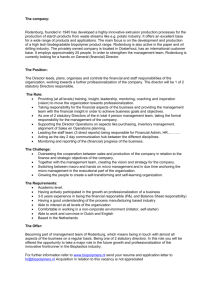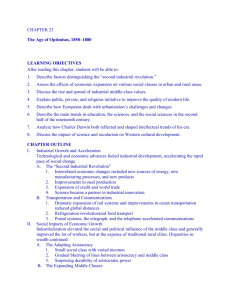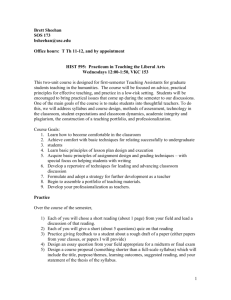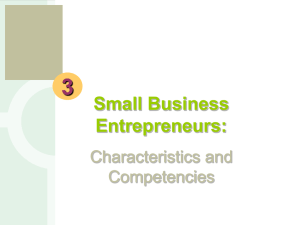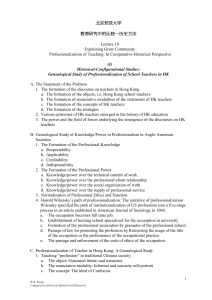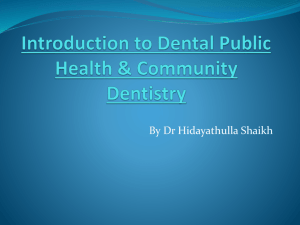Features of Professionalization of Youth Under Modern Conditions Vera Alexandrovna Fedotova
advertisement
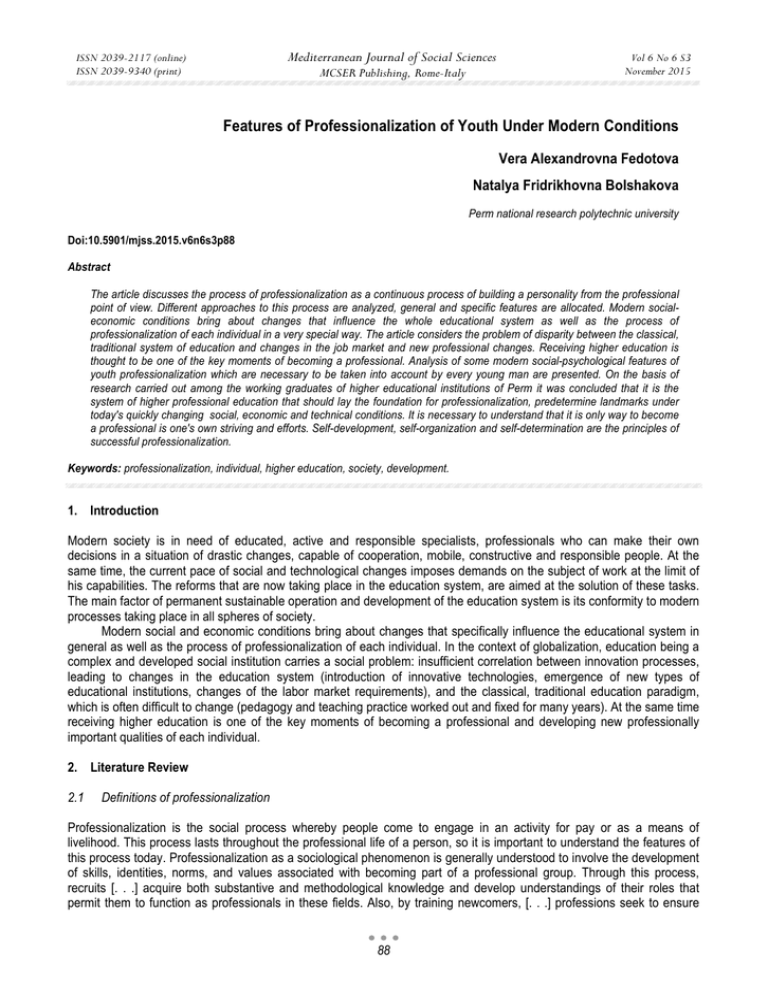
Mediterranean Journal of Social Sciences ISSN 2039-2117 (online) ISSN 2039-9340 (print) MCSER Publishing, Rome-Italy Vol 6 No 6 S3 November 2015 Features of Professionalization of Youth Under Modern Conditions Vera Alexandrovna Fedotova Natalya Fridrikhovna Bolshakova Perm national research polytechnic university Doi:10.5901/mjss.2015.v6n6s3p88 Abstract The article discusses the process of professionalization as a continuous process of building a personality from the professional point of view. Different approaches to this process are analyzed, general and specific features are allocated. Modern socialeconomic conditions bring about changes that influence the whole educational system as well as the process of professionalization of each individual in a very special way. The article considers the problem of disparity between the classical, traditional system of education and changes in the job market and new professional changes. Receiving higher education is thought to be one of the key moments of becoming a professional. Analysis of some modern social-psychological features of youth professionalization which are necessary to be taken into account by every young man are presented. On the basis of research carried out among the working graduates of higher educational institutions of Perm it was concluded that it is the system of higher professional education that should lay the foundation for professionalization, predetermine landmarks under today's quickly changing social, economic and technical conditions. It is necessary to understand that it is only way to become a professional is one's own striving and efforts. Self-development, self-organization and self-determination are the principles of successful professionalization. Keywords: professionalization, individual, higher education, society, development. 1. Introduction Modern society is in need of educated, active and responsible specialists, professionals who can make their own decisions in a situation of drastic changes, capable of cooperation, mobile, constructive and responsible people. At the same time, the current pace of social and technological changes imposes demands on the subject of work at the limit of his capabilities. The reforms that are now taking place in the education system, are aimed at the solution of these tasks. The main factor of permanent sustainable operation and development of the education system is its conformity to modern processes taking place in all spheres of society. Modern social and economic conditions bring about changes that specifically influence the educational system in general as well as the process of professionalization of each individual. In the context of globalization, education being a complex and developed social institution carries a social problem: insufficient correlation between innovation processes, leading to changes in the education system (introduction of innovative technologies, emergence of new types of educational institutions, changes of the labor market requirements), and the classical, traditional education paradigm, which is often difficult to change (pedagogy and teaching practice worked out and fixed for many years). At the same time receiving higher education is one of the key moments of becoming a professional and developing new professionally important qualities of each individual. 2. Literature Review 2.1 Definitions of professionalization Professionalization is the social process whereby people come to engage in an activity for pay or as a means of livelihood. This process lasts throughout the professional life of a person, so it is important to understand the features of this process today. Professionalization as a sociological phenomenon is generally understood to involve the development of skills, identities, norms, and values associated with becoming part of a professional group. Through this process, recruits [. . .] acquire both substantive and methodological knowledge and develop understandings of their roles that permit them to function as professionals in these fields. Also, by training newcomers, [. . .] professions seek to ensure 88 ISSN 2039-2117 (online) ISSN 2039-9340 (print) Mediterranean Journal of Social Sciences MCSER Publishing, Rome-Italy Vol 6 No 6 S3 November 2015 that the work of [the group] will continue congruent with certain principles and practices (Levine, 2001). According to V. Markova professionalization is the process of becoming a professional that takes place throughout life, starting with the period when the young person chooses a profession, including the period of social and labor and professional activities. Completed by the end of the professional career it is an ongoing long-term process of becoming a professional. Analyzing different views about the process of professionalization, we find two essentially different approaches to the definition. The first approach involves development and self-development of personality. Professionalization is considered within a more general concept of socialization, as one of its components. Development of professional skills is associated with development of the person, personal space being wider than professional one (Klimov, 1996). The literature notes that "professional" and "personal" in humans may be related in different ways: a person may perform his duties formally serving time at work and considering it to be waste of time or it may be full inclusion in intensive work when professional values are integrated into personal space which is much broader and more multidimensional. The second approach involves the mastery of the profession, the inclusion of a person in a certain system of professional activity. In this case, the process of professionalization means raising the level of professionalism resulting in improvement of work and development of new and professionally important qualities (Markova, 1996). However, there are several common things highlighted by all authors: interaction of individual characteristics of the human and his socio-cultural environment; stage process; interdependence of personal development and professional development (Zolotoverkhova, 2008). Key performance indicators of the process of professionalization are divided into objective and subjective ones. Objective indicators allow to assess the extent to which a person responds to profession requirements (performance, reliability, quality of human labor). Subjective indicators identify the extent to which professional activity responds to the person (degree of satisfaction of the working man, treating oneself as a professional, etc.) (Markova, 1996). Professionalization - is not only a long, continuous, and complex process. Its content depends on the rate of mastering the profession, individual characteristics as well as external factors and conditions that are often beyond control of the subject himself. 2.2 Structure and stages of professionalization process In its structure there are two components which can occur in parallel so the development can immediately go in several directions: 1) Mastering all the new challenges of professional activity 2) Developing tools, techniques to address each new professional challenge and consolidation of psychological qualities needed by a specialist to deal with these problems. Stages of the process of professionalization include: vocational guidance, professional selection, career choices taking into account individual features, abilities and preferences, vocational education, development of rules and regulations of the profession, professional adaptation, i.e. introduction into the profession, specialization, professional development, retraining, flourishing professional activities, formation and awareness of oneself as a professional, expansion of the profession by personal experience contribution, development of personality by means of professional work, and, finally, completion of and retiring from active professional work. At all these stages of the process of professionalization, it is important to understand that under present conditions a person simply needs to operate within the new educational values and priorities. A new approach to the organization of the processes of professionalization of future specialists is that higher education is seen as an open system operating on the basis of universal values and updating personal meanings: creation of conditions for development of the person, capable of self-determination and self-realization. 2.3 Modern social-psychological characteristics of professionalization Now let us turn to the analysis of some contemporary social and psychological characteristics of the professionalization of young people. These characteristics should be understood and taken into account in the activities of every young person. In our opinion, the first difficulty faced by the people in the process of professionalization is the choice of profession, taking into account their abilities and capabilities. The choice of profession "once and forever", as the well89 ISSN 2039-2117 (online) ISSN 2039-9340 (print) Mediterranean Journal of Social Sciences MCSER Publishing, Rome-Italy Vol 6 No 6 S3 November 2015 known Russian psychologist E.A. Klimov said, was a prejudice (Klimov, 2007). A modern man must focus on the rapidly changing conditions and the possibility of changing his profession. The general trend of professional dynamics in today's industrialized world and in the Information society manifests itself in inevitability of the choice of several professional careers. Under changing conditions rigid and narrow professionalization may be an obstacle to the progressive development of the individual. This trend is observed in the course of professional adaptation in a new socio-cultural environment, while maintaining the quality of professional work under the conditions of socio-economic and information technology changes, as well as in various extreme situations. Hence it is important for students not only to form a broader professional profile, but also to be oriented to the possibility of changing occupation which is not rare today. At the stage of professional adaptation, high demands and complexity of the profession often do not correspond to its low social status, which leads to rejecting a professional role by a person and as a consequence, to internal conflicts. This creates preconditions for destructive forms of social behavior and using the profession for personal gain, since people do not always get the necessary conditions to successfully implement themselves as representatives of the profession. Though this is a common problem there is a way out. Socio-psychological studies have shown that if a person is focused at such priorities as social activities, self-development, self-realization in the professional sphere, creativity, spiritual development, parenting, caring for other people, there is a high level of life satisfaction, positive self-esteem , positive attitude toward people and a generally positive view of the world. The level of well-being and financial position is not so important. 3. Research and Methods 3.1 Participants and instruments In May 2015 there was conducted a pilot case study in the city of Perm, which interviewed 100 people. Methods of gathering sociological data was questionnaire. The sampling frame was employed graduates of Perm universities under the age of 30 years. Our sociological study aims to reveal the essence of the concept and the process of professionalization, to study the structure and factors of the process of professionalization in modern organizations, to identify and assess the level of professionalization among working young people aged under 30 years and those with higher education. During the implementation of this objective we set the following main tasks: 1) to identify the most important theoretical and methodological foundations of the process of professionalization, to reveal the process of formation and the structure of the process of professionalization; 2) to determine the level of professionalization of working graduates of Perm universities under the age of 30; 3) to identify factors influencing the process of professionalization of working young people aged up to 30 with higher education; 4) to identify the types of professionalization levels and make their extended characteristics. 4. Findings and Discussion To assess the level of professionalization of working young people aged up to 30 with higher education we developed a typology of levels of professionalization, namely, respondents were divided into workers with high, medium and low level of professionalization. Empirical indicators of this typology are satisfaction with work in the organization, implementation of work in time, the degree of activity of the subject. The method for constructing the typology is fixing these three main empirical indicators and making the integral indicator. Thus, the typology presented is characterized as follows: High level of professionalization- employees are fully satisfied with their work in the organization, always perform their work on time, are active in the main field of activity, cope with the implementation of production tasks, fulfill norms by 100% or more; Medium level of professionalization- workers are not entirely satisfied with thei work in the organization, they do not always perform their work on time, although generally these workers cope with the implementation of production norms by 100%; Low level of professionalization - workers are not satisfied with their work in the organization, they do not often perform their work on time and not always cope with implementing production tasks. Our research has shown that at the present time the majority of respondents have a high level of professionalization (Figure 1). 90 Mediterranean Journal of Social Sciences ISSN 2039-2117 (online) ISSN 2039-9340 (print) Vol 6 No 6 S3 November 2015 MCSER Publishing, Rome-Italy Figure 1 – Levels of professionalization The study showed that the most common is the type of workers with a high level of professionalization, according to our data it is 44% of respondents, the average level of professionalization is characteristic for 37% of respondents. And the least common type is workers with a low level of professionalization. Such demographic characteristics as gender and age have a significant impact on the process of professionalization, they are interrelated with and interdependent on the process. The predominant type among men is the medium level of professionalization, among women the high level of professionalization is more common. It may be noted that the low level of professionalization is more common among men than among women. The study showed that with increasing age there is a decrease in the number of respondents with a low level of professionalization. Work experience as a factor of professionalization is as important as age and they are closely associated. It is a central factor among others that affect strengthening or destruction of social and labor relations between workers in the enterprise. In sociology, it is decided to study three indicators: total length of service, work experience in the enterprise and in the profession. In our study it was found that the impact of these indicators on the level of professionalization is ambiguous. For example, among workers with a big work experience in the enterprise and the profession all types of workers with different levels of professionalization are presented. Although it should be noted that workers with the middle level of professionalization are characterized by work experience of not more than 3 years in the enterprise as well as in the profession. According to material prosperity two groups were revealed: middle-income and lower-middle income. Among those who have an average income there are 4 times more people with a high level of professionalization, but with income below the average there are 2 times more people who have a low level of professionalization. Thus, with increasing the level of material conditions the increase in the number of respondents with a high level of professionalization was observed. Next we consider distribution of types of the workers studied in the enterprises of different forms of ownership (Table 1). Table 1 – Form of ownership and professionalization levels (in % to the number of respondent) High Middle Low Private 38 51 11 State 25 55 20 Respondents with a middle level of professionalization dominate in state-owned enterprises as well as in private ones. Comparing public and private types of enterprises, we find that the percentage of employees with a high level of professionalization in public enterprises is lower than in private ones (25% and 38%, respectively). Thus, the main factors affecting the increase in the professionalization are gender, age, experience, financial situation, ownership of the enterprise. Let us analyze the dependence of the level of professionalization of employees on the frequency of changing jobs (Table 2). 91 Mediterranean Journal of Social Sciences ISSN 2039-2117 (online) ISSN 2039-9340 (print) Vol 6 No 6 S3 November 2015 MCSER Publishing, Rome-Italy Table 2 – The frequency of changing jobs by respondents with different levels of professionalization (in% of respondents) High Average Low Never 82 17 0 1-2 times 23 77 0 3-4 times 0 63 37 It is interesting that the majority of workers who have never changed their work place have a high level of professionalization, among those who has changed a job 1-2 times the average level of professionalization prevails. Thus, the more often they change the place of work, the lower is the level of professionalization of the respondents. The impact of such factors as the threat of unemployment can be traced in the following way. The respondents who do not experience the threat of unemployment, have a high level of professionalization. Those who find it difficult to assess the threat of unemployment for themselves have a low level of professionalization. Respondents with an average level of professionalization give all kinds of answers, the most part of them perceiving a threat of unemployment for themselves. Awareness of the situation on the labor market is lower among those who have a low level of professionalization. Among the respondents with high and medium level of professionalization awareness of unemployment, ranking prestigious professions, job vacancies in the specialty is almost twice higher as opposed to respondents with low levels of professionalization. Thus, having an idea of the real situation on the labor market it is easier for workers to adapt to labor. Among the main professionalization indicators work in the profession is particularly notable. The respondents, working in their profession or a close one have a high level of professionalization (50% and 47% of respondents). Half of the respondents whose work is not related to the obtained profession have a low level of professionalization. Thus, working in the profession is characterized by a high level of professionalization. It was found that difference in the rate of mastery of skills is almost negligible for a high and a medium level of professionalization, but among those who have a low level of professionalization there is an increasing number of workers who experience difficulties in the process of work. Next we examine the way the level of professionalization is affected by performance indicators. It may be noted that in general among workers with a high level of professionalization there are 1.5 times more respondents who raised the qualification this year or 1-2 years ago than among workers with an average level of professionalization. Workers with a low level of professionalization either did not raise their qualifications at all or raised it more than three years ago. Thus, the higher the level of professionalization is, the more workers are seeking to upgrade their skills. Impact of loss of working time on the level of professionalization is ambiguous. Consider the data in Table 3. Table 3. Loss of working time for workers with different types of professionalization ( in% of respondents in groups) No loss Less than an hour 1-2 hours 3 or more hours High 29 31 21 19 Medium 40 30 13 17 Low 0 33 29 41 Despite the fact that, in general, among respondents with a low level of professionalization there are more of those who work with loss of working hours comparing with respondents with a higher level of professionalization, no direct dependence is revealed it is worth noting that among the respondents with a low level of professionalization there are more of those who work with losses of 3 hours or more than among respondents with a higher level of professionalization. In general, employees with a high level of professionalization say they have less loss of working time. So among workers with a high level of professionalization 29% of respondents work without loss of time, slightly more respondents lose at least 1 hour (31%), the remaining 40% lose up to 3 hours or more. It is interesting that only the respondents with a low level of professionalization do not say that they work without loss of working time. Although, in general, the higher the level professionalization of the workers, the less time they lose. Employees with a high level of professionalization are more often in a good mood at work than employees with a lower level of professionalization. In addition, workers with a low level of professionalization often work in a good or unstable mood. More than a half of workers with a middle level of professionalization say that their mood at work is 92 Mediterranean Journal of Social Sciences ISSN 2039-2117 (online) ISSN 2039-9340 (print) Vol 6 No 6 S3 November 2015 MCSER Publishing, Rome-Italy different, although among these workers there are most of the respondents who say that their mood is bad. 2/3 of respondents with a high level of professionalization notice that they more often work in a good mood, than in a bad mood. Only 2% of employees with a high level of professionalization note that the mood at work is bad. Thus, in general, employees with a higher level of professionalization are often in a good mood at work. Respondents with a low level of professionalization are not inclined to note that they have a bad mood at work. Next, consider the impact of the level of professionalization on the opinion about the possibility to disclose their abilities at work (Table 4). Table 4 – Opportunities to disclose their abilities for workers with different types of professionalization (in % of respondents in groups) High 42 45 13 Good opportunities Limited opportunities No opportunities Medium 31 46 23 Low 29 57 14 Among all types of workers with different levels of professionalization workers dominate who believe that the opportunity to disclose their abilities are limited. However, the higher the level of professionalization is, the more employees find opportunities to disclose their abilities at work. Vice versa, the lower the level of professionalization is, the more workers claim that opportunities to disclose their abilities at work are restricted. So, it can be concluded that employees with a high level of professionalization have higher performance indicators, they are more often trained, they are in a better mood at work and they have more opportunities to disclose their skills at work. Next, we analyze how employees with different levels of professionalization evaluate certain aspects of social and labor relations. Firstly, we consider the attitude to the work of the respondents with different levels of professionalization. It was found that those who think their work is interesting and important by itself regardless of the payment, are usually related to the low level of professionalization (almost half of the respondents) Perhaps it is connected with a low personal estimate as a professional and low material claims. Among respondents with an average level of professionalization the respondents dominate who believe that work is a source of livelihood (41%). It is interesting that among the respondents who believe that work is important, but there are more interesting things, there is a greater number of respondents with a high level of professionalization (51%). Perhaps confidence in their professionalism lets them reveal individual abilities in other areas. The attitude of management to employees may affect the level of professionalization. Consider the data in Table 5. Table 5 – The attitude of management to workers with different levels of professionalization (in% of respondents groups). Indifferent Unstable Friendly High 42 0 58 Medium 27 35 38 Low 34 10 56 Among the respondents with a biased and indifferent attitude of the management the most common type is workers with a high level of professionalization. The attitude of the management to workers with a middle level of professionalization is unstable (35%). It is interesting that employees with a high level of professionalization do not notice any unstable attitude. Good workers with either a high or a low level of professionalization experience equally friendly attitude from the management. Thus, a better attitude does influence the level of professionalization of employees. Unstable attitude of the management results in increasing the number of employees with a lower level of professionalization. It may be noted that workers with a high and a low level of professionalization feel a more stable attitude to and they are more categorical in defining the attitude of the management Let us analyze the impact of management style on the level of professionalization (Table 6). 93 ISSN 2039-2117 (online) ISSN 2039-9340 (print) Mediterranean Journal of Social Sciences Vol 6 No 6 S3 November 2015 MCSER Publishing, Rome-Italy Table 6 – The management style for workers with different levels of professionalization (in% of respondents in groups). Authoritarian Liberal Democratic High 37 45 18 Medium 32 15 53 Low 16 23 61 It is interesting that in the authoritarian style of management workers with a high level of professionalization are predominant, workers with a middle level of professionalization are a bit less common. In the democratic management style the most common type is the type of workers with a low level of professionalization, there are 3 times fewer workers with a high level of professionalization. In the liberal management style the most of the employees have a high level of professionalization. Thus, it may be noted that in the authoritarian and liberal management style workers with a high level of professionalization prevail, in the democratic management style workers with lower levels of professionalization are more common. We can say that in the harder style of management with less freedom for independent decision-making there are more workers with a high level of professionalization. In the democratic management style workers with lower levels of professionalization dominate. 5. Concluding Remarks Today's generation of young people must come back to understanding and emotional experiencing of the fact that study and work is a serious tension and self-overcoming. Work generates in a person a sense of his own importance, positive changes as a result of effort. Self-development of the man in work is connected with the appearance of opportunities for further choice, with increasing the degree of freedom of action. And, in our opinion, it is the system of higher education that should lay the foundation for such understanding of the process of professionalization in everyone's life, to predetermine the guidance under today's rapidly changing social, economic and technological conditions. the study showed that workers with a higher level of professionalization are more successful in work. They lose less time, they cope with production norms and confidence in their own professionalism lets them disclose abilities in other areas. It is found that this type of workers is more common in the authoritarian and liberal type of management. Workers with a high level of professionalization are mostly women with work experience of more than 3 years in the profession who has never changed their place of work. For a young worker it is necessary to understand clearly that he can become a professional only with his own efforts. Self-development, self-organization and self-determination are the principles of successful professionalization. References Comments to the Federal Law of December 29, 2012 N273-FZ "On Education in the Russian Federation". Source: July 20, 2015, from the HTTP: // portal.edurm.ru/files/File/120213/180213/komm.rtf. Gusinsky, E.N. & Turchaninova, Y.I. (2000) Introduction to Philosophy of Education: M.: Logos. Klimov, E.A. (1996) Professional Psychology. M .: Publisher "Institute of Applied Psychology", Voronezh: NPO "MO-DEC". pp. 400. Levine, Felice J. (2001) "Professionalization, Certification, Labor Force: United States." International Encyclopedia of the Social and Behavioral Sciences. Ed. Neil J. Smelser and Paul B. Bates. Oxford: Elsevier. Markova, A.K. (1996) Psychology of professionalism. International Humanitarian Fund "Knowledge". pp. 312. Zolotoverhova, Y. (2008). Gender approach to the study of effectiveness of professional activity in modern society. Journal of Theory and Practice of Community Development, 2. Source http://cyberleninka.ru/article/n/gendernyy-podhod-k-izucheniyu-effektivnostiprofessionalnoy-deyatelnosti-v-sovremennom-obschestve#ixzz3gbLciCHe Mitina, L.M. (1997) Personal and professional development of the person under the new socio-economic conditions // Questions of psychology. ʋ 4. pp.45-48. Mitina, L.M. (2003) Psychology of competitive personality. M.: Publisher: Moscow psychology-social inst; Voronezh MODEK. Bodrov, V.A. (2001) Psychology of professional suitability. Textbook for high schools M. PER SE. pp. 511. Klimov, E.A. (2004) Psychology of professional self-determination. Textbook for students of higher pedagogical institutions. M.: Publishing center "Academy". pp. 304. Yermolayeva, E.P. (2008) Psychology of social realization of a professional. M .: Institute of Psychology, Russian Academy of Sciences. Druzhilov, S.A. (2010) Individual human resource as the basis of formation of professionalism: a monograph. Voronezh: Scientific Book. pp. 240. 94
